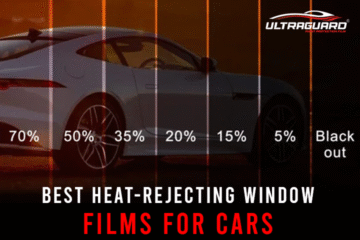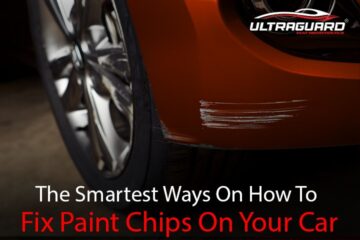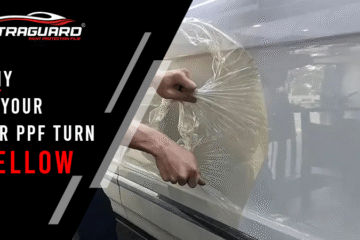The sheen of a new car is undeniable. That factory-new finish, the bright color – it’s beautiful. But unfortunately, it’s also extremely exposed. Every journey, every car park, every stone chip is a potential attack on your paint. This is where car Paint Protection Film steps in as your vehicle’s cloak of invisibility. Investing in Paint Protection Film for car is not merely keeping things looking nice; it’s keeping your car valuable and its original pristine state intact for years to come.

Why is Paint Protection Film for cars a Smart Investment?
In addition to the obvious protection of your paint, there are many good reasons to invest in PPF:
Maintains Resale Value
Your vehicle will always sell for a higher price when the time arises because a car with good paint is always in demand. Paint Protection Film for car keeps your paint showroom new, greatly enhancing your resale value.
Maintains Aesthetic Appeal
Who would not want a car that is always in top shape? PPF keeps your car looking its best, maintaining its rich gloss and bright color, scratch- and chip-free.
Self-Healing Properties
Self-healing is often included in contemporary PPFs. Small scratches and swirl marks on the film can be removed with the use of heat (sun or hot water), preserving the smoothness of the film.
Resistant to Environmental Contaminants
Bug guts, bird droppings, and tree sap can be extremely corrosive to the paint on your car if not treated. PPF creates a buffer, which keeps these contaminants from adhering to and harming your clear coat.
Easy to Clean
The non-porous, smooth surface of PPF means cleaning your vehicle is easy. Dirt and grime are not as likely to stick, and washing is a faster, more efficient process.
Long-Term Protection
Top-grade PPF can endure for several years, with ongoing protection without the necessity for regular reapplication.
Now, applying Paint Protection Film to your whole car is the ultimate protection, but it is a heavy investment. For most car owners, protecting the most vulnerable spots strategically is a more realistic and affordable alternative. So, let’s explore the top 5 spots on a car to protect with Paint Protection Film for car.
Top 5 Areas on a Car to Protect with Paint Protection Film-
When deciding where to use Paint Protection Film, consider the areas of your vehicle that are most at risk from road waste, weather factors, and day-to-day wear and tear. These are the top five important areas:
1. Front Bumper
Without a doubt, the front bumper is the absolute top priority when it comes to Paint Protection Film for a car. Why? Because it’s the first point of impact for almost everything your car encounters on the road. Stone chips, bug splatters, sand, gravel, and even minor parking lot scuffs are all direct threats to your front bumper’s paint.
Vulnerability
The front bumper gets a constant pounding. Whether driving on the freeway or crawling through city traffic, there are always other cars kicking up litter and sending it flying directly at your bumper.
Cost of Repair
Repainting a bumper can be an expensive and time-consuming endeavor. Professional repainting means sanding, priming, painting, and clear coating, and getting the factory finish will be difficult.
Aesthetic Effect
Scratches and dents on the front bumper are easily visible and take away a lot from your vehicle’s looks.
PPF Solution
Coating the entire front bumper with Paint Protection Film gives it a strong, imperceptible barrier. It takes the beating of road trash, deflecting chips, and scrapes. The self-repair nature of advanced PPF can even ease minor scuffs from careless bumps. This will keep your bumper unblemished, maintaining your car’s showroom look and ultimately, its resale value.
2. Hood (Leading Edge or Full Hood)
The hood is also a first choice for road rash, particularly its leading edge. As your vehicle travels down the road, the hood faces the same barrage of trash as the front bumper, though perhaps at a slightly different angle.
Vulnerability
Similar to the bumper, the hood is a big, front-facing surface. Stone chips tend to bounce off the road and hit the lower front edge of the hood.
Visibility
The hood is right out there in your eyesight as you approach the vehicle. Any damage here is easy to notice.
PPF Solution
You have two choices here. The most popular choice is to cover the front edge of the hood (usually the first 18-24 inches). This guards the most vulnerable area to stone chips and bug strikes. A full hood application of Paint Protection Film is the best way to get the most protection, especially on luxury or high-performance cars. This offers total coverage, protecting the whole surface against environmental waste, chipping, and scratches. A full hood application also gets rid of the visible seam that may occur with a partial hood application, giving a seamless and clean finish.
3. Fenders (Front Quarter Panels)
The front fenders, most particularly the part right behind the wheels, are well-known for attracting stone chips and road trash. As your tires rotate, they function like catapults, shooting little stones, gravel, and other gritty material onto your fender’s lower portions.
Vulnerability
The curved shape and location nearest the wheels make the front fenders extremely susceptible to “tire-kick up.” Particularly if you frequently travel on gravel roads or drive through construction sites a lot.
Damage Pattern
You’ll commonly observe a “sandblasted” appearance on bare fenders, which involves a myriad of small chips and scratches dulling the paint finish over time.
PPF Solution
A robust layer of protection against these high-speed strikes can be accomplished by applying Paint Protection Film for car to the front fenders, particularly the lower portion and the area next to the wheel wells. This keeps the paint smooth and glossy and stops it from chipping, protecting your car’s precise lines.
4. Side Mirrors
Your side mirrors may appear like tiny targets, but they are rather exposed. Situated in full view on the sides of your vehicle, they are exposed to flying objects on highways and vulnerable to unplanned bangs and scrapes in congested parking spots.
Vulnerability
Mirrors tend to be the first thing encountered in tight areas or while brushing against overgrown undergrowth. They are also likely to be the recipient of stone chips and bug splatter at speed.
Repair Difficulty
The complexity of side mirrors’ modern shapes can render touch-up paint or repainting difficult and costly, sometimes necessitating the disassembly of the mirror assembly.
PPF Solution
Individual-cut piece of Paint Protection Film for your side mirrors gives you great protection against chips, scratches, and scuffs. It’s a minor cost that can prevent you from spending major repair bills and maintaining these important parts in top condition. The film’s clarity allows for no distortion of your mirror’s reflective surface.
5. Door Edges and Door Cups
These locations are frequently neglected but see a surprising level of use and abuse from day-to-day use.
Door Edges
With each time you open your car door, particularly in a small parking space, there’s a possibility of the edge of another car, a wall, or a pillar. These little chips and paint transfers are extremely prevalent and can add up rapidly.
Door Cups (Behind Handles)
This is the space immediately behind your door handles where your rings and fingernails continually scrape against the paint when you open the door. Eventually, this causes a buildup of fine scratches, swirl marks, and dullness, resulting in an unattractive “halo” effect.
PPF Solution
Pre-cut or custom-cut strips of Paint Protection Film can be applied directly to the edges of doors, creating a strong barrier against chips and dings. Likewise, small clear strips of PPF can be applied within the door cups, serving as a sacrificial layer to take in the wear of hands and jewelry, ensuring the paint below remains flawless. These are high-use areas where Paint Protection Film provides real, everyday protection that makes a visible difference.
Outside the Top 5: Other Regions Worth Considering for Paint Protection Film
Although the top five regions provide the most important protection, based on your driving style and vehicle type, you may also want to consider Paint Protection Film for:
Rocker Panels
These are the lower body panels between the front and rear wheels. They are very prone to stone chips and road tar, particularly if you drive on gravel or dirt roads.
Rear Bumper (Load Zone)
If you often load and unload goods from your trunk, the top edge of your rear bumper can be easily scratched. A small bit of PPF here can avoid unsightly damage.
A-Pillars
Especially at faster speeds, some road residue also hits these pillars that encircle your windshield.
Fog lights & Headlights
PPF applied especially for lights can protect them from stone chipping, haze, and yellowing, maximizing visibility and avoiding costly replacement.
Roof (Front Section)
Like the hood, the front section of the roof may be exposed to falling trash or even pebbles kicked up by large vehicles.
Selecting the Right Paint Protection Film for a Car Installer!
Not only is the quality of the Paint Protection Film itself important, but so too is the skill of the installer. A skilled installer will:
Work in a Clean Environment
Defects will result from dust and particles under the film.
Use Premium Materials
Skilled installers make use of top-tier PPF brands that are well-known for their clarity, durability, and self-healing properties.
Employ the Right Techniques
To ensure a smooth, bubble-free finish, this calls for precise cutting, meticulous surface preparation, and error-free application.
Warranty
A competent installation will be assured of both the product and their work.
Winding Up-
Your vehicle is an investment, and its paint job is the first thing everyone sees.
Safeguarding that finish with Paint Protection Film for car is one of the optimal means of keeping it looking great, holding its value, and having that “new car” appearance for many years to come. By cleverly applying Paint Protection Film to the most exposed places – your front bumper, hood, fenders, side mirrors, and door edges/cups – you form an invisible, long-lasting barrier against the harsh conditions of the road and normal use. Though the initial expense of Paint Protection Film is an outlay, think of it as an investment that yields rewards in the way of retained value, lower repair bills, and sheer driving pleasure at seeing a car that’s always looking its very best. Don’t let your car’s beauty be blunted by stone chips and scratches; take advantage of the strength of Paint Protection Film and drive with peace of mind.
FAQs (Frequently Asked Questions)About Paint Protection Film-
Q1: How long does the Paint Protection Film (PPF) last?
Typically, high-quality PPF from reputable companies can last anywhere from 5 to 10 years, and in some instances, more than that.
Q2: Will Paint Protection Film damage my car’s paint when removed?
If properly installed and, more importantly, taken off by a professional, Paint Protection Film shouldn’t damage your original factory paint on a vehicle.
Q3: Does PPF alter the look of my car’s paint?
Contemporary Paint Protection Film for car is optically clear and nearly invisible after installation. It makes your car’s paint glossier and doesn’t turn yellow or crack over time, unlike many older films.
Q4: Is it possible to wax or ceramic coat over Paint Protection Film?
Yes, sure! You may (and should) continue to wash and maintain your car normally despite having Paint Protection Film applied.
Q5: How much is Paint Protection Film for a car?
The cost of Paint Protection Film for car is quite varied, depending on several factors like area covered, size, and complexity of the vehicle, film type, installer’s experience, etc. Although the average cost of a full car wrap can be ₹66K to ₹2.8L.
Q6: Can I do Paint Protection Film myself?
While smaller pre-cut pieces for door cups or edges might be attempted by an extremely patient and careful DIYer, using Paint Protection Film on large panels like bumpers or hoods is highly discouraged for beginners and can only be done by a professional detailer.
Q7: Does PPF self-heal?
Many contemporary, high-quality Paint Protection Film products incorporate self-healing technology. This is where scratches, swirls, and minor surface abrasions on the film surface will disappear when exposed to heat. This heat can come from the sun, hot water, or even the application of a heat gun (cautiously).




0 Comments